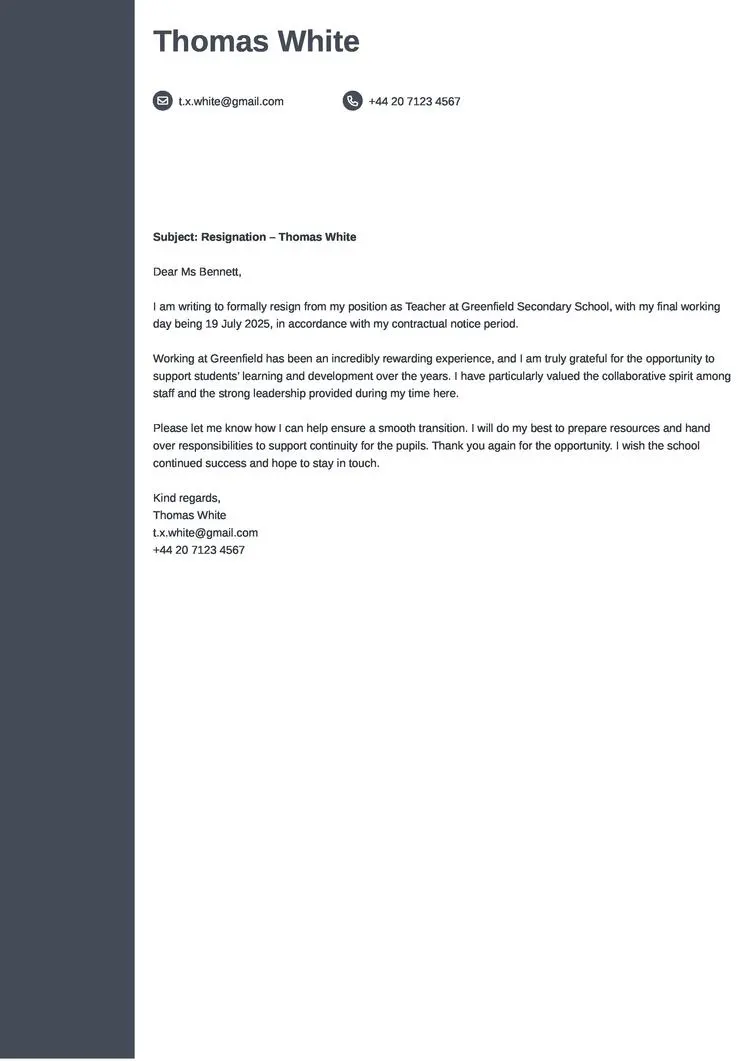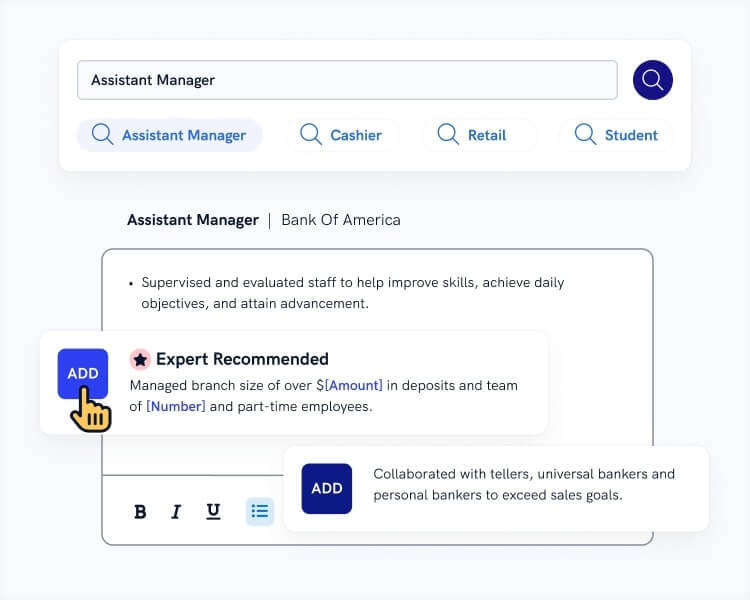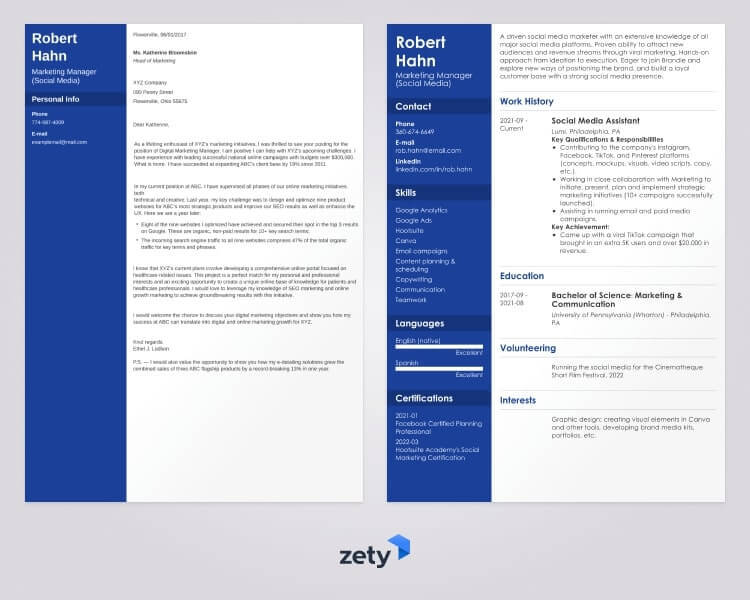How to Write a Resignation Letter: Template + Examples
Create your CV nowA professional resignation letter is a must when you're ready to leave a job. This formal document helps you leave on good terms, maintain positive relationships, and set a respectful tone as you move forward in your career.
In this guide, I’ll cover everything you need to know about resignation letters. You’ll see the proper structure, expert tips, a ready-to-use template, and an example of a resignation letter that will show you exactly how it’s done. Let’s begin!
Create your resignation letter now
What is a resignation letter?
A resignation letter is a formal notice given to your employer to inform them of your intention to leave your current position. It serves as a record of your departure, outlining key details such as your final working day and, in some cases, the reasons for leaving.
Here are the key elements of a resignation letter:
- Formal statement: Inform your employer that you want to resign from the job.
- Job title and company name: Mention your specific job title and the name of the company.
- Final day of employment: Express clearly what your last day will be.
- Optionally:Reason why you’re leaving: You might say the reason why you’re leaving, such as focusing on other opportunities.
- Willingness to help: Offer that you can help smooth the transition, for example, by training a new employee who’ll take over.
- Optionally: Appreciation: Say thank you for the experience you gained while working for this employer.
Whether printed or emailed, a resignation letter shows respect for your employer and helps ensure a smooth exit.
💡 Trying to land a job and not quit one? This might be helpful: How to write a cover letter
Resignation letter example
Subject: Resignation – Thomas White
Dear Ms Bennett,
I am writing to formally resign from my position as Teacher at Greenfield Secondary School, with my final working day being 19 July 2025, in accordance with my contractual notice period.
Working at Greenfield has been an incredibly rewarding experience, and I am truly grateful for the opportunity to support students’ learning and development over the years. I have particularly valued the collaborative spirit among staff and the strong leadership provided during my time here.
Please let me know how I can help ensure a smooth transition. I will do my best to prepare resources and hand over responsibilities to support continuity for the pupils. Thank you again for the opportunity. I wish the school continued success and hope to stay in touch.
Kind regards,
Thomas White
t.x.white@gmail.com
+44 20 7123 4567
How to write a resignation letter
A clear and well-structured letter of resignation ensures that there’s no confusion about your departure, giving both you and your employer time to plan for what comes next. And that’s what I call being a full-on professional. Not to mention, it’s the quality your colleagues, supervisors, recruiters, and employers will remember you by.
Whether you're moving on to a new opportunity or taking time to refocus, a polite and thoughtful resignation letter can leave a lasting positive impression. Follow this step-by-step guide to ensure your resignation letter strikes the right tone and covers all the essential details:
1. Consider the type of resignation letter
Before writing your resignation letter, ensure it aligns with your specific situation. There are several things to consider:
- Tone and formality. Do you need something simple, or more formal and detailed? For most jobs, a short, polite letter is enough. In more corporate roles, a professional tone with a short thank-you can go a long way.
- Recipient. Are you writing to your manager or the HR department? A letter to your manager may be more personal, while one to HR should cover practical details, such as notice periods or final pay.
- Reason for leaving. What’s behind your decision? If you’re changing careers, relocating, retiring, or stepping away for personal reasons, you can mention it briefly if relevant. But remember, you’re not obliged to go into detail.
- Timing. When are you leaving the company? Most letters provide the standard notice, but if you're going immediately or offering extra time, your letter should reflect this.
Once you’ve answered all these questions, writing the letter of resignation becomes much simpler.
2. Start with a formal greeting
The first thing your manager will read is the greeting, so it sets the tone for the entire letter. It’s important to maintain a formal and respectful tone, especially if you’ve had a friendly relationship. A professional salutation reinforces that this is an official communication.
- Start with “Dear [Name].”
- Avoid overly friendly openers, such as “Hi” or “Hello.”
- Double-check the spelling of their name and title.
3. Clearly state your intention to resign
Your manager should understand immediately that you’re resigning and when it takes effect. Being upfront ensures there’s no confusion or need for follow-up to clarify your message.
- Use precise language and avoid vague phrases.
- Keep the tone firm but respectful.
- Don’t leave any room for interpretation.
4. Mention your final working day
It’s essential to confirm the exact date of your final working day, so your employer can start making plans. This shows that you understand your notice period and are following protocol. It also prevents any misunderstandings about your availability.
- Refer to your employment contract to confirm the notice period.
- Phrase it professionally.
- Give as much notice as possible to show consideration.
5. Express your gratitude
Even if your experience wasn’t perfect, it’s good practice to say thank you. A sentence or two of appreciation demonstrates maturity and helps maintain a positive relationship. Gratitude can also make your letter feel more personal and sincere.
- Keep it genuine, but brief.
- Mention specific positives if possible (e.g. team support, skills gained).
- Avoid sarcasm or backhanded compliments.
6. Offer to help with the transition
A smooth handover is in everyone’s best interest. Offering to help with the transition shows you care about leaving on good terms and not making things more complicated for your team. It’s a simple way to reinforce your professionalism and goodwill.
- Offer to assist with handovers, training or documentation.
- Only offer what you genuinely intend to do.
7. End on a positive note
Your last impression is as important as the first one. Aim to end on a warm and respectful note. It’s a chance to reaffirm positive feelings, even if you’re eager to move on. Ending graciously can leave the door open for future references or professional connections.
- Avoid negativity, even if you’re leaving due to issues.
- Keep the tone friendly but formal.
8. Use a polite closing
Like any formal letter, it’s important to wrap things up with a proper closing. A courteous sign-off helps to maintain a respectful tone throughout. It also confirms your name and serves as a professional end to your message.
- Common closings include:
- Kind regards,
- Yours sincerely,
- Best regards,
- Follow it with your name on the next line.
- Include a signature if submitting a hard copy.
9. Format the letter of resignation template professionally
Be a true professional right till the end—make sure your letter is formatted correctly. Follow these tips:
- Use one-inch margins on all sides.
- Put your contact information on the right, and all the rest of the contents on the left side.
- Pick a professional font that’s easy to read at 11 or 12 points.
- Adapt a professional letter template by simply using the ones available in our builder.
When making a CV in our builder, drag & drop bullet points, skills, and auto-fill the boring stuff. Spell check? Check. Start building a professional CV template here for free.
When you’re done, Zety’s CV builder will score your CV and tell you exactly how to make it better.
Resignation letter template
Here’s a simple resignation letter template you can personalise for any role:
Subject: Resignation – [Your Full Name]
Dear [Manager's Name],
I am writing to formally resign from my position as [Your Job Title] at [Company Name]. My final working day will be [Date], in accordance with my notice period.
I would like to thank you and the team for the opportunities and support I’ve received during my time here. I’ve learned a great deal and truly appreciate the experience.
Please let me know how I can assist with the transition process. I will do everything I can to ensure a smooth handover.
Kind regards,
[Your Full Name]
[Your Contact Details]
💡 There’s one more job-related letter you might want to learn to write. Visit our guide: How to write a motivation letter
Tips for before and after sending your resignation letter
Leaving a job is a true rollercoaster of emotions, so it’s better to have a plan on how to do it right: not only for the company, but also for yourself.
Follow these practical tips to ensure a respectful and positive departure from your role:
What to do before sending your letter of resignation?
- Speak to your manager first. Whenever possible, have a direct conversation with your manager before submitting your resignation in writing. This approach is respectful and helps avoid surprises and maintain open communication.
- Keep your letter polite and professional. Regardless of your reasons for leaving, avoid negativity or venting in your resignation letter. A neutral, courteous tone preserves relationships and keeps future opportunities open.
- Consider potential counteroffers. Reflect on whether you might be willing to stay if offered better terms, such as a raise, promotion, or flexible working arrangements. Being clear on this helps you respond calmly if asked.
- Review your contract. Understand your notice period, holiday entitlements, and any other obligations before submitting your letter to avoid misunderstandings.
What to do after sending your resignation letter?
- Maintain professionalism until your last day. Continue to meet your responsibilities and remain committed during your notice period. Leaving on a strong note reflects well on you and your work ethic.
- Help with the handover. As you mentioned in your resignation letter, assist with training your replacement or preparing handover notes to ensure a smooth transition for your team.
- Communicate openly and positively. Be honest but tactful when colleagues ask about your departure, and approach exit interviews with constructive feedback.
- Avoid burning bridges. Stay courteous and professional, even if you are eager to leave. Maintaining good relationships can benefit you in the future.
- Complete all exit formalities. Return any company property, finalise paperwork, and provide HR with all necessary information to close your employment smoothly.
- Keep professional connections. Where appropriate, connect with colleagues on LinkedIn or exchange contact details to maintain your network beyond your current role.
Taking care throughout the entire resignation process helps you leave on good terms and opens doors for future opportunities. But what’s even more important, it helps you with your well-being.
Once you’re ready for departure, we’ve got all you need for creating an interview-worthy CV and cover letter.
Plus, a great cover letter that matches your CV will give you an advantage over other candidates. You can write it in our cover letter builder here. Here's what it may look like:
See more cover letter templates and start writing.
Here’s what to include in a resignation letter:
- The date of writing the letter
- The recipient’s name, whether it’s your manager or the HR representative
- Clear statement of your intention to resign
- A specified date of your final day of work
- Reason for leaving (optional)
- An expression of your gratitude for the work and an offer to assist with the transition
- Contact information
Thanks for reading my article! Good luck with your future moves!
About Zety’s Editorial Process
Our editorial team has thoroughly reviewed this article to ensure it follows Zety’s editorial guidelines. Our dedication lies in sharing our expertise and providing you with actionable career advice that offers you real value. Every year, the quality of our content attracts 40 million readers to our site. But that’s not all – we conduct original research to gain a detailed understanding of the labour market. We take pride in being cited by top universities and leading media outlets in the UK and worldwide.






